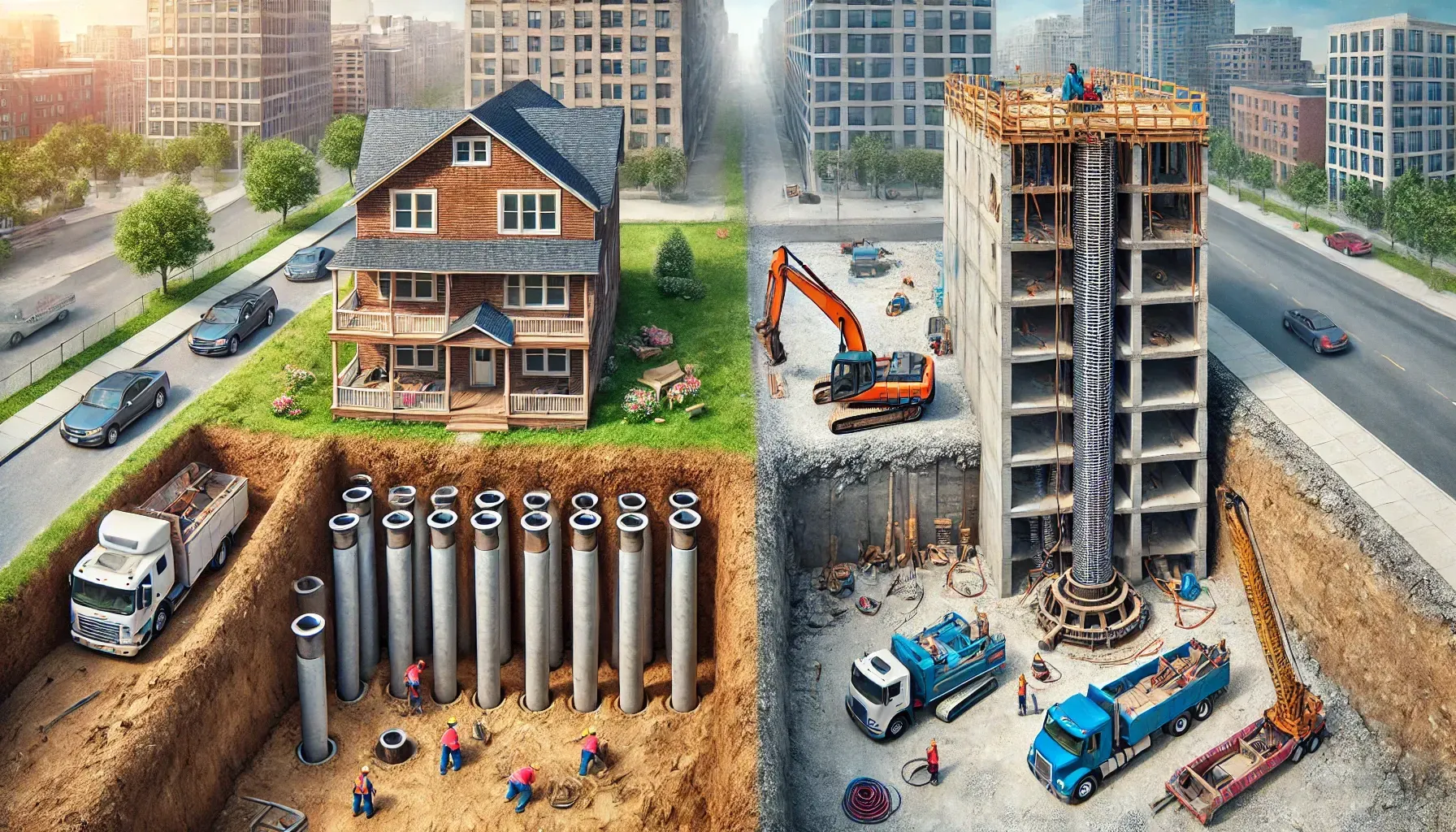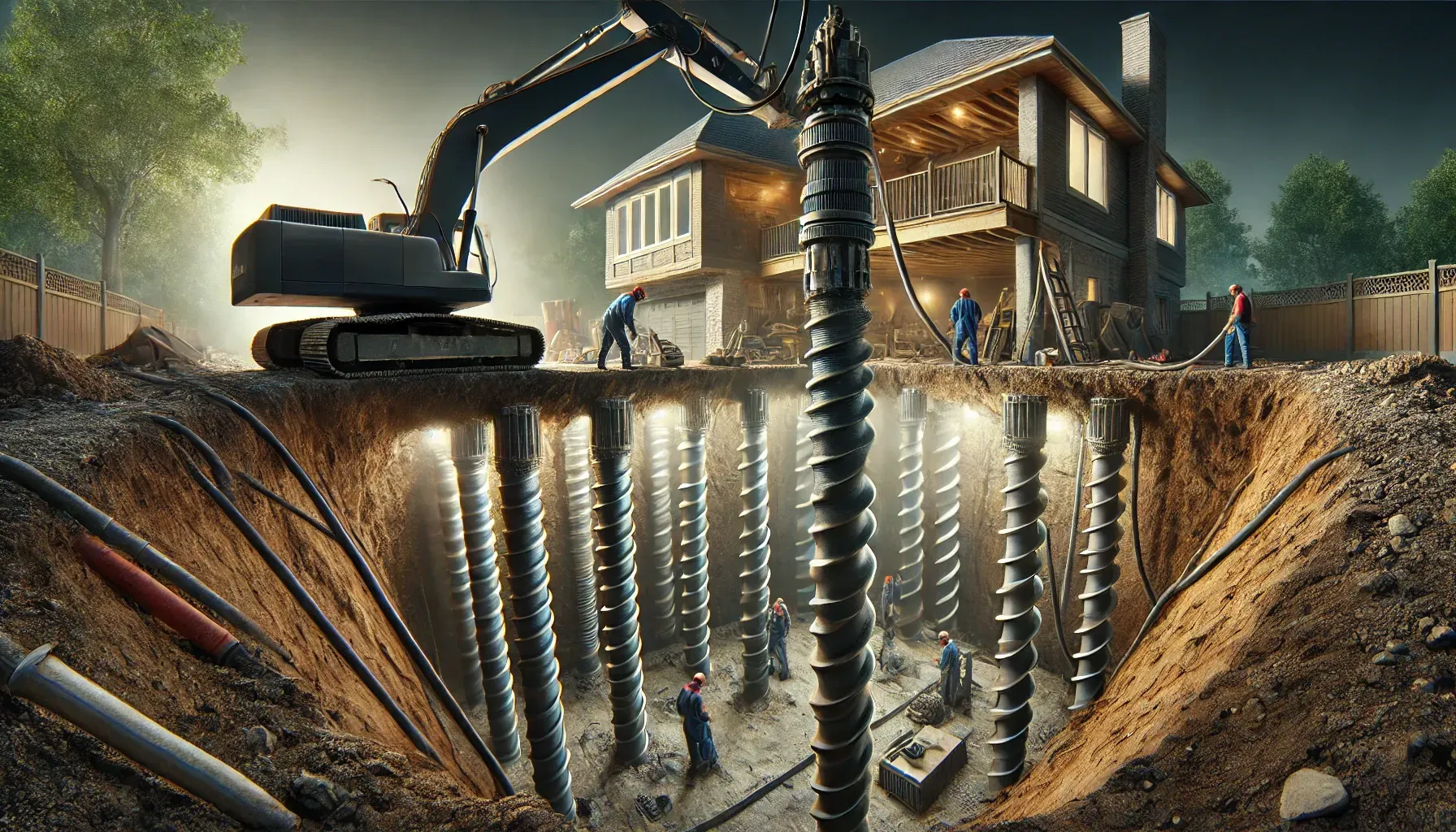What are Helical Piers, Benefits, Installation process, Cost
Discover the Benefits, Installation Process, and Cost of Helical Piers for Residential and Commercial Foundations. A Comprehensive Guide to Modern Foundation Repair Solutions.
When it comes to foundation repair and support, helical piers are the unsung heroes of modern engineering. Whether you’re dealing with a sinking deck, a tilting house, or just curious about advanced foundation repair technologies, you’re in for a treat.
Foundation issues can feel like the end of the world. Cracks in walls, doors that won’t close properly, and sinking floors are more than just aesthetic nightmares, they’re structural alarms. But here’s the good news: modern technology has given us solutions that are faster, more efficient, and less invasive than ever before.
Among these, helical piers stand out as one of the most versatile and effective options available today.
Let’s take a deep dive into the world of helical piers, what they are, why they’re amazing, how they work, and whether they’re the right solution for your home or commercial property. Trust us, by the end of this guide, you’ll know all the ins and outs, so you can tackle any foundation issue with confidence.
What Are Helical Piers?
Helical piers, also known as helical piles or helical screw piles, are foundation support systems designed to stabilize and support structures. Picture a giant screw being twisted into the ground , that’s essentially how these work.
These piers are comprised of steel shafts with helical plates, or "flights," welded to them. The helical shape allows them to burrow deep into the soil with minimal resistance while creating a secure anchor point for the structure above.
How Do They Work?
Helical piers are driven into the ground using hydraulic machinery. As they’re screwed into the soil, the helical plates create a strong grip by transferring the weight of the structure to stable layers of earth. They’re ideal for both new construction and retrofitting existing buildings.
Why the Name “Helical”?
The term comes from their screw-like shape. The helical flights resemble the spiral of a screw, and that design is the secret sauce behind their load-bearing capability. Without it, the pier wouldn’t be able to achieve the same depth and stability.
A Brief History of Helical Piers
Helical piers aren’t some flashy new invention; they’ve been around since the early 19th century. In the 1830s, Irish engineer Alexander Mitchell pioneered the use of a similar design to anchor lighthouses and docks into muddy seabed's. Spoiler: those lighthouses are still standing, which says a lot about their durability. Mitchell’s original idea was simple yet ingenious: by using a helix-shaped design with steel screw piles, he created stability in weak soils and laid the groundwork for modern geotechnical engineering.
By employing torque to drive the piers deep into the soil, engineers of the time ensured a solid anchor point for critical structures. Fast forward a couple of centuries, and today’s helical piers have become an indispensable solution in North America for stabilizing everything from homes to bridges. They’re a key part of deep foundation systems, often used in projects involving basements, crawl spaces, and joists. Their versatility and reliability make them an ideal choice for modern construction and waterproofing challenges.
Modern Advancements
Today’s helical piers have come a long way, thanks to significant advancements in materials like high-strength steel, precision welding techniques, and innovative designs that maximize performance. Engineers now use specialized gear to assess soil conditions and apply the exact amount of torque needed to install the piers. This ensures a customized fit for every project, whether it’s a large-scale commercial build or a budget-friendly residential repair.
One of the most notable improvements is their resistance to corrosion, which is vital for long-term durability in various environmental conditions. These piers also play a crucial role in drainage management and preventing structural issues caused by shifting soils or water infiltration. Additionally, many manufacturers now offer warranties that guarantee performance over decades, giving property owners peace of mind.
Helical piers have evolved into more than just a foundation solution, they’re a cornerstone of cutting-edge engineering. From screw piles to tailored designs for basements, crawl spaces, and even specialized applications like lightweight joists, these tools have revolutionized how we approach stability and durability in construction.
Types of Helical Piers and Their Composition
Not all helical piers are created equal. Depending on your needs, you might encounter different types tailored to specific applications. Let’s break them down:
1. Round-Shaft Helical Piers
- Description: These piers feature a cylindrical shape, which provides excellent stability under compression.
- Best For: Heavy-duty applications such as large commercial buildings or homes with significant load demands.
- Advantages:
Their design helps resist bending, making them ideal for projects requiring high load-bearing capacity.
2. Square-Shaft Helical Piers
- Description: These piers have a square-shaped shaft, making them better suited for tension applications.
- Best For: Smaller structures like decks, porches, and light residential buildings.
- Advantages:
They’re easier to install in tighter spaces and perform well under tensile stress.
Materials
Most helical piers are made of high-strength galvanized steel. This material is chosen for its durability and resistance to corrosion, ensuring that the piers can withstand harsh soil and weather conditions for decades. Additionally, some piers come with special coatings for extra protection in environments with high moisture or acidity.
Benefits of Helical Piers
Helical piers aren’t just another pretty face in the foundation repair world. They’ve got some serious advantages that make them a top choice for homeowners and contractors alike:
1. Versatility
Whether you’re stabilizing a house, deck, or commercial property, helical piers work across the board. Their ability to adapt to different soil conditions and structural requirements makes them an all-around winner.
2. Quick Installation
With minimal excavation required, installation is often faster than other foundation solutions. Think hours, not days. This makes them a convenient choice for projects with tight deadlines.
3. Minimal Disruption
No one likes a torn-up yard. Helical piers keep the mess to a minimum, preserving your landscaping and reducing cleanup time. Your neighbors might not even know you’ve had foundation work done.
4. Suitable for Poor Soil Conditions
Sandy, expansive, or weak soils? No problem. Helical piers dig deep to find stable ground, making them effective even in challenging environments.
5. Cost-Effective
Compared to full foundation replacements, helical piers save you big bucks while delivering long-term stability. They’re a smart investment for anyone looking to protect their property value.
6. Eco-Friendly
Because they require less excavation and use fewer materials, helical piers have a smaller environmental footprint than traditional foundation solutions.
Drawbacks and Limitations of Helical Piers
Of course, no solution is perfect. Helical piers do have their drawbacks, and it’s important to understand them before making a decision:
1. Not Ideal for All Soil Types
Rocky or highly compact soils can make installation tricky. In some cases, alternative foundation solutions may be more practical.
2. Cost for Heavy Loads
While affordable for most residential projects, helical piers for large commercial loads can get pricey due to the need for additional materials and customization.
3. Requires Professional Installation
This isn’t a weekend DIY project. Specialized equipment and expertise are essential for proper installation. Cutting corners could lead to instability and costly repairs down the road.
Cost of Helical Piers
The burning question: how much do helical piers cost?
Factors That Influence Cost:
- Depth of Installation: Deeper installations require more materials and labor.
- Type of Pier: Round-shaft piers tend to cost more than square-shaft piers.
- Load Requirements: Higher load demands may require additional piers or customization.
- Regional Labor and Material Costs: Prices vary depending on location and availability.
Average Cost:
- Residential Installations: Typically range between $1,500 and $2,500 per pier.
- Decks and Patios: Costs are slightly lower, averaging $500 to $1,000 per pier.
- Large Commercial Projects: Costs can soar upwards of $3,000 per pier, depending on the scope.
Professional vs. DIY Installation

When it comes to installing helical piles, you might feel tempted to grab a wrench and try tackling the project yourself. After all, how hard can it be to screw a pier into the ground, right? Well, the truth is, it’s a lot more complicated than it seems. Let’s break down the pros and cons of professional and DIY approaches so you can make the best decision for your project.
Professional Installation
Hiring professionals to handle your helical pier installation ensures that your project is completed correctly, safely, and efficiently. Here’s why it’s worth considering the pros:
- Expertise: Trained installers have the knowledge to assess soil conditions, calculate load requirements, and determine the optimal placement and type of pier for your specific needs.
- Specialized Equipment: Professional installation relies on hydraulic machinery and torque monitoring systems to ensure the pier reaches the necessary depth and stability.
- Warranty and Reliability: Most professional services come with a warranty, giving you peace of mind that the foundation repair will stand the test of time.
- Time Efficiency: What could take weeks for an inexperienced DIYer might only take a day or two for professionals.
DIY Installation
On the flip side, attempting to install helical piers yourself might seem like a cost-saving measure, but it comes with significant challenges and risks:
- Equipment Limitations: Without access to professional-grade tools, achieving the proper depth and torque is nearly impossible.
- Increased Risk of Errors: Mistakes during installation can compromise the pier’s integrity, leading to costly repairs down the line.
- Permitting and Compliance: Foundation work often requires permits and strict adherence to building codes, which can be confusing for non-professionals.
- Longer Completion Time: A task that takes professionals a day might take weeks for a DIY enthusiast to finish.
Verdict
Unless you have extensive experience and access to specialized equipment, professional installation is the safest, most efficient, and most reliable option for helical piers. It’s worth the investment to ensure your foundation’s stability and long-term durability.
Best Applications of Helical Piers
Helical piers are like the Swiss Army knives of foundation repair, versatile, reliable, and suitable for a variety of situations. Whether you’re stabilizing a small patio or supporting a massive commercial building, helical piers deliver unmatched performance.
Residential Applications
- Foundation Repair: Perfect for addressing settlement issues in older homes or stabilizing new builds.
- Decks and Patios: Provide a sturdy, long-lasting foundation for outdoor structures, especially in areas with weak soil.
- Retaining Walls: Reinforce walls to prevent collapse and ensure longevity in landscapes with uneven terrain.
Commercial Applications
- Industrial Buildings: Support heavy machinery and equipment with a reliable foundation.
- Bridges and Roadways: Reinforce structures in challenging environments like riverbeds or soft soils.
- New Construction: Create stable foundations for large-scale projects such as warehouses, skyscrapers, and malls.
Commercial vs. Residential Usages of Helical Piers
Though the technology behind helical screw piles remains consistent, their application differs based on the scale and requirements of the project. Let’s explore these differences:
Residential Uses
In homes and small-scale projects, helical piers are most often used to:
- Address foundation settlement issues in aging properties.
- Stabilize outdoor additions like decks, porches, and patios.
- Reinforce homes in areas prone to soil movement or erosion.
Commercial Uses
In commercial settings, helical piers excel in projects requiring higher load capacities and precision:
- Supporting multi-story buildings and heavy structures.
- Stabilizing infrastructure like bridges, retaining walls, and parking garages.
- Serving as the backbone of large-scale industrial applications.
When Should They Be Used?
Helical piers aren’t a one-size-fits-all solution, but they’re perfect for specific scenarios. Here are some common situations where they shine:
- Signs of Foundation Settlement: Cracks in walls, uneven floors, and sticking doors often indicate underlying structural issues.
- Weak or Expansive Soils: In areas where the ground can’t support traditional foundations, helical piers provide a stable alternative.
- Adding Extra Loads: Planning an addition or second story? Helical piers ensure your existing foundation can handle the increased weight.
Right Type of Piers for My House
Choosing the right type of pier for your home can feel overwhelming, but it boils down to three key factors:
- Soil Conditions: Weak, expansive, or sandy soils may require deeper installations or specialized pier designs.
- Load Requirements: Larger and heavier structures demand piers with higher load-bearing capacities.
- Structure Type: Square-shaft or round-shaft piers may be better suited depending on the specific needs of your home or project.
A professional assessment is crucial to determine the optimal solution for your property.
Push Piers vs. Helical Piers
Push piers and helical piers are both effective foundation repair solutions, but they serve different purposes. Let’s compare:
Push Piers
- Installation: Driven straight into the ground using hydraulic pressure.
- Best For: Heavy, vertical loads in stable soils.
- Advantages: Excellent for large-scale stabilization projects requiring deep support.
Helical Piers
- Installation: Screwed into the ground using helical flights.
- Best For: A variety of soil types and smaller to medium-sized projects.
- Advantages: Quicker installation, less invasive, and highly versatile.
Comparing Helical Piers to Other Repair Solutions
When considering foundation repair options, how do helical piles stack up against traditional methods? Here’s a quick
comparison:
Vs. Concrete Piers
- Helical Piers: Faster installation, less excavation, and better suited for weaker soils.
- Concrete Piers: Require extensive excavation and longer curing times, making them less practical for time-sensitive projects.
Vs. Slabjacking
- Helical Piers: Provide a permanent fix by addressing the root cause of instability.
- Slabjacking: Acts as a temporary measure, ideal for minor leveling but not long-term stabilization.
Frequently Asked Questions (FAQs)
Do Helical Piers Really Work?
Yes, helical piers are a proven and reliable solution for foundation repair and stabilization. They are engineered to provide long-term support by transferring structural loads to stable soil layers or bedrock. Their design has been refined over centuries, and modern installation techniques ensure optimal performance for a wide range of applications.
How Many Helical Piers Do I Need?
The number of helical piers required depends on several factors, including:
- The weight and size of your structure.
- The type and condition of the soil.
- The distribution of loads across your foundation. A professional assessment is necessary to determine the exact number of piers needed for your specific project.
How Far Down Can Helical Piers Go?
Helical piers can be installed to depths ranging from 10 to over 100 feet, depending on the soil conditions and the load-bearing requirements. The goal is to reach a stable layer of soil or bedrock capable of supporting the structure’s weight. Depth is determined using torque monitoring during installation.
Where Can I Buy Helical Piers?
Helical piers are available through foundation repair contractors, construction supply companies, and specialized manufacturers. It’s important to source them from reputable suppliers to ensure high-quality materials and performance. Some suppliers also offer customization based on specific project needs.
Are Helical Piers Cheaper Than Concrete?
While the upfront cost of helical piers can sometimes be higher than concrete piers, they often prove more cost-effective in the long run. Helical piers require less excavation, are quicker to install, and perform better in challenging soil conditions. Additionally, they minimize disruption to landscaping, saving on restoration costs.
Want to explore more options? check out our blog on pier and beam foundations.
Conclusion
Helical piers are the unsung heroes of foundation repair. They’re versatile, cost-effective, and durable, making them the go-to solution for both residential and commercial projects. Whether you’re stabilizing a deck, addressing foundation settlement, or planning a large-scale build, helical piers are a reliable option that deliver long-term results.
Don’t underestimate the importance of a solid foundation. If you’re facing structural issues or planning a new project, consult with experienced professionals to explore how helical piers can benefit your property. A strong foundation isn’t just a luxury—it’s a necessity
Key Takeaways
- Helical Piers Are Highly Versatile: They can stabilize homes, decks, patios, and even large commercial structures in a variety of soil conditions.
- Quick and Minimal Disruption: Helical piers require less excavation and installation time compared to traditional methods, preserving landscaping and reducing project timelines.
- Proven Technology: With origins in the 1830s, helical piers have a long history of successfully stabilizing structures, from lighthouses to modern homes.
- Professional Installation Is Key: While DIY might seem tempting, professional installation ensures proper depth, torque, and compliance with building codes.
- Cost-Effectiveness Over Time: Though the upfront cost might be higher than concrete piers, their durability and minimal maintenance needs make them a smart long-term investment.
- Suitable for Various Applications: From residential to commercial, helical piers are adaptable for small projects like decks and large-scale infrastructure like bridges.
- Eco-Friendly Solution: Helical piers use fewer materials and create less waste, making them a more sustainable choice for foundation repair and stabilization.
So what are you waiting for, just give us call or leave us a message to get a quote instantly. We are experts of helical piers foundation repair. We will be there with you with our gear and excavator as soon as possible.
Protect Your Investment from Structural Damage, Water & Mold Serving the Tri-Sate Area
PA License #PAHIC169133
DE License #2022707501
NJ License #13VH12234100
Hours of Operation
Mon to Fri 7am to 7pm
Sun to Sun: 7am - 7pm
©Philadelphia Foundation Repair & Waterproofing


